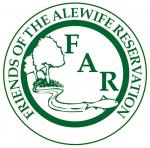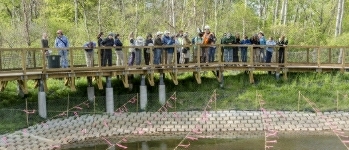By David Morimoto Posted Sep. 6, 2014 @ 6:30 pm
This guest commentary was first published in the Sept. 4 issue of the Arlington Advocate. It is the first of a two-part series; check back next week for the second piece.
The trees have something to say to us.
I am a Lorax, one of many Loraxes, who speak for the trees as we listen to them in our studies and meanderings. My last name loosely interpreted means 'essence of the forest'. We speak for other plants, birds, mammals, insects and all the creatures great and small, including humans that inhabit and love the Silver Maple Forest (SMF). We stand as one tribe of Loraxes. We are dissipated beings who share heart and soul space and a common connection to the SMF.
The Lorax message gained from listening, exploring, and discussing, is clear. To build on the Silver Maple Forest in Cambridge and Belmont would be akin to the last Truffula tree falling and the Brown Barbaloots disappearing in Dr. Seuss's prescient tale many of us know and love. And so would disappear the great-horned owls, herons, and a vast diversity of other SMF and Alewife Reservation inhabitants, creatures great and small interconnected into the Alewife ecosystem fabric.
They along with the wealth of ecological services, not the least of which include carbon dioxide abatement, flood control, and much needed natural open space for people, and habitat for our nonhuman kin. Unless….
Although we've engendered a decade of walks, protests, rallies, vigils, spiritual ceremonies, testimonies and statements, meetings and forums of all kinds, fundraisers, concerts, art shows, the development is still most likely to happen despite the will of so many thousands who live near the forest. How can this be? Could we donate or sell the land and call it O'Neill Reservation? A hero would be born.
We are Homo sapiens, brilliant creatures. We named ourselves so. As we work collectively to understand our planet and our small place, we should know better. Here's what we do know in the science field: As the world and especially the U.S. becomes urbanized (80 percent of Americans live in cities, and more than 50 percent do so globally), natural green space increases greatly in importance, especially as one of the two most densely populated cities in New England (Cambridge), and in the Boston Basin landscape that is more than 72 percent paved.
Also, when the urban wild green space is located at a hub of human transit, making it accessible for study, enjoyment, service, education, and nature therapy, it is truly an important parcel.
We know about ecosystem services. These services more than justify keeping the SMF intact, and they are more than services; they connect us: carbon sequestration, flood control, temperature moderation and pollution abatement, etc., all supported by biodiversity in ecological action, the direct of experience of which is invaluable to human health, but not in the calculus for the development.
David Morimoto is associate professor of biology, director of the College of Liberal Arts and Sciences and the natural science and mathematics program at Lesley College. Check back next week for the second half of the column.
Archived 2014-09-13 from http://arlington.wickedlocal.com/article/20140906/NEWS/140907535/2011/OPINION
- Home
- Directions
- FAR Wildlife Blog
- Calendar
- News
- Donate Now
- Get Social!
- Storm Water Wetlands
- Plants and Restoration
- Photos
- Videos
- About & Projects
- Master Plan for Alewife
- Archive
- Newsletters
- Contact
 Presentation Spotlighting Alewife Reservation
Presentation Spotlighting Alewife Reservation
 Follow us on Twitter
Follow us on Twitter
 Like us on Facebook
Like us on Facebook
 Follow us on Instagram
Follow us on Instagram
Forward our web address to a friend!
- An Urban Gem - Alewife Reservation Nature Preserve
- Envisioning The Silver Maple Forest
- History and Policies of Cambridge, Belmont, and DEP
- Storm Water Wetlands
- Friends of Alewife Reservation brochure
(front, back) - Technical Analysis of Upper Alewife Basin
- Watershed: An Excursion in Four Parts
- The River Is A Restless Spirit: Life in the floodplain forest
-
Assessment of Silver Maple forest for DEP Adjudicatory hearings and
Patrick Fairbairn, author of the Assessment - Community Native Garden Flora
The
Alewife Reservation
is a unique natural resource for the communities of Belmont, Arlington and Cambridge
and home to hundreds of species, including hawks, coyotes beavers, snapping turtles, wild turkeys and muskrats,
the reservation is a unique natural resource for the community.
Historical information (Powerpoint)
Friends of Alewife Reservation works to protect and restore this wild area and the surrounding area for the water quality, native plants, animals and over 90 bird species with paths for walking, running and biking, recreation, and for classroom education and research. We regularly steward and preserve the Reservation area for wildlife and for the enjoyment of present and future generations.

(video)
By-Laws
About Friends of Alewife Reservation
Statement of Purpose
Citizen Forester newsletter archive
The Birds of the Cambridge Region of Massachusetts

by William Brewster 1906
Nuttal Ornithological Society
Biodiversity Study of Alewife Reservation Area: Species, Habitat, Ecosystems

Inventories by David Brown, wildlife assessor (2003, 2004.) Published by and available from FAR for $10. Write or call for your copy. (sample)
Updated Dave Brown Inventories (2008, 2010)
Inventories of Alewife Reservation Wetland Plants by Walter Kittredge, Botanist (2013)

